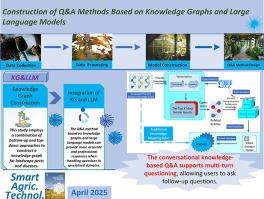Construction of Q&A methods based on knowledge graphs and large language models-improving the accuracy of landscape pest and disease Q&A
IF 5.7
Q1 AGRICULTURAL ENGINEERING
引用次数: 0
Abstract
With the development of urban landscaping, the problem of garden diseases and pests is becoming increasingly severe. Large language models have garnered significant attention for their ability to understand user intent and provide answers. The introduction of knowledge graphs has provided a high quality knowledge base for large language models. This study combines knowledge graphs (KGs), large language models (LLMs) and other technologies to design an intelligent question-answering (Q&A) model for garden pests and diseases. The main work carried out is as follows:
Build a knowledge graph for garden diseases and pests by collecting high-quality data through web crawling and literature analysis. Identify key entities and relationships to construct a conceptual pattern layer. Applying the ERNIE-BiLSTM-CRF model to extract knowledge from unstructured data. Through experiments, it is found that the accuracy, recall and F1 value of the knowledge extraction model proposed in this study are all more than 92%, superior to other models.
Propose a Q&A method that integrates the garden pest and disease KG with the ERNIE-Bot-turbo model. By vectorizing the knowledge and using similarity matching, the most relevant data is retrieved, combined with the question to form prompts, and input into the language model to generate natural language answers. Experiments comparing our method with ERNIE-Bot-turbo and ChatGLM-6B showed that our approach performs well on simple, moderate, and complex problems, avoiding misleading answers for irrelevant questions. It outperforms both models in accuracy, achieving a 90% accuracy rate for simple questions.

基于知识图谱和大语言模型的问答方法构建——提高景观病虫害问答的准确性
随着城市园林绿化事业的发展,园林病虫害问题日益严重。大型语言模型因其理解用户意图并提供答案的能力而获得了极大的关注。知识图的引入为大型语言模型提供了高质量的知识库。本研究结合知识图谱(knowledge graphs, KGs)、大型语言模型(large language models, LLMs)等技术,设计了一个园林病虫害智能问答(intelligent question-answer, Q&;A)模型。主要工作如下:通过网络抓取和文献分析,收集高质量的数据,构建园林病虫害知识图谱。识别关键实体和关系以构建概念模式层。应用ERNIE-BiLSTM-CRF模型从非结构化数据中提取知识。通过实验发现,本文提出的知识提取模型的准确率、查全率和F1值均在92%以上,优于其他模型。提出了将园林病虫害KG与ERNIE-Bot-turbo模型相结合的Q&; a方法。通过知识矢量化和相似性匹配,检索最相关的数据,结合问题形成提示,输入到语言模型中生成自然语言答案。它在准确率上优于这两种模型,在简单的问题上达到了90%的准确率。
本文章由计算机程序翻译,如有差异,请以英文原文为准。
求助全文
约1分钟内获得全文
求助全文

 求助内容:
求助内容: 应助结果提醒方式:
应助结果提醒方式:


